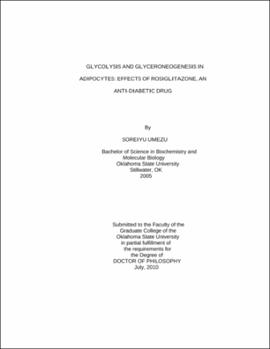| dc.contributor.advisor | Soulages, Jose L. | |
| dc.contributor.author | Umezu, Soreiyu | |
| dc.date.accessioned | 2013-11-26T08:22:59Z | |
| dc.date.available | 2013-11-26T08:22:59Z | |
| dc.date.issued | 2010-07 | |
| dc.identifier.uri | https://hdl.handle.net/11244/6680 | |
| dc.description.abstract | Findings and Conclusions: | |
| dc.description.abstract | To gain better understanding of the action of the anti-diabetic drug, rosiglitazone (RGZ), we investigated some aspects of the metabolism of glucose, pyruvate and TG in mouse 3T3L-1 adipocytes. | |
| dc.description.abstract | The major findings of this study include: 1) The rate of glucose and TG metabolism in 3T3L-1 adipocytes can be directly determined using specific activity (cpm/nmol) of lactate released into the medium, 2) Adipocytes display various changes depending on the condition of incubation. Isoproterenol-treated adipocytes increase glucose consumption in the absence of insulin. Furthermore, the increased rate of lipolysis in these adipocytes facilitates the synthesis of G-G of TG using glucose carbons, 3) RGZ increases the rate of two opposite pathways, lipolysis and FA uptake and re-esterification, in adipocytes regardless of the conditions of incubation (basal, low lipolytic, and high lipolytic states, 4) RGZ increases the rate of the futile cycle of TG in synthesis biased fashion. This could explain why RGZ treated adipocytes have a reduced output of NEFA, 5) RGZ-treated adipocytes utilize larger amounts of glucose for the synthesis of G-G and this may be the cause of the enhanced rate of FA re-esterification. The greater utilization of glucose for G-G synthesis would be possible, at least in part, because RGZ upregulates the expression of HK, LDH, GPDH, and ATGL, and 6) Neither glyceroneogenesis nor GK play significant roles in NEFA lowering effect of RGZ. Overall the findings in this study provide new insights to the lipid metabolism of adipocytes and NEFA lowering effects of RGZ. | |
| dc.description.abstract | Overall the findings in this study provide new insights to the lipid metabolism of adipocytes and NEFA lowering effects of RGZ. | |
| dc.format | application/pdf | |
| dc.language | en_US | |
| dc.rights | Copyright is held by the author who has granted the Oklahoma State University Library the non-exclusive right to share this material in its institutional repository. Contact Digital Library Services at lib-dls@okstate.edu or 405-744-9161 for the permission policy on the use, reproduction or distribution of this material. | |
| dc.title | Glycolysis and glyceroneogenesis in adipocytes: Effects of rosiglitazone, an anti-diabetic drug | |
| dc.contributor.committeeMember | Yu, Chang-An | |
| dc.contributor.committeeMember | Mort, Andrew | |
| dc.contributor.committeeMember | Dillwith, Jack | |
| osu.filename | Umezu_okstate_0664D_10920.pdf | |
| osu.accesstype | Open Access | |
| dc.type.genre | Dissertation | |
| dc.type.material | Text | |
| dc.subject.keywords | adipocytes | |
| dc.subject.keywords | glucose metabolism | |
| dc.subject.keywords | glyceroneogenesis | |
| dc.subject.keywords | lipid metabolism | |
| dc.subject.keywords | rosiglitazone | |
| dc.subject.keywords | type ii diabetes | |
| thesis.degree.discipline | Biochemistry and Molecular Biology | |
| thesis.degree.grantor | Oklahoma State University | |
